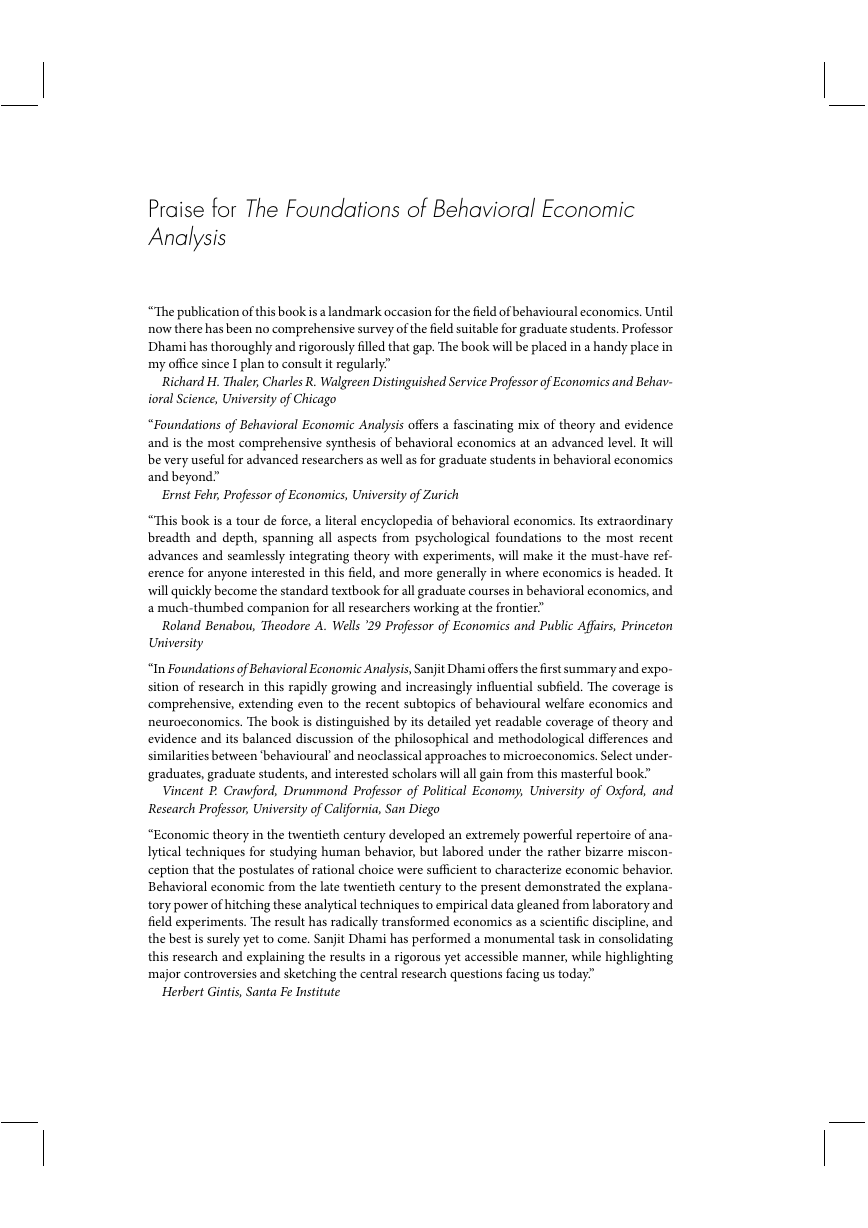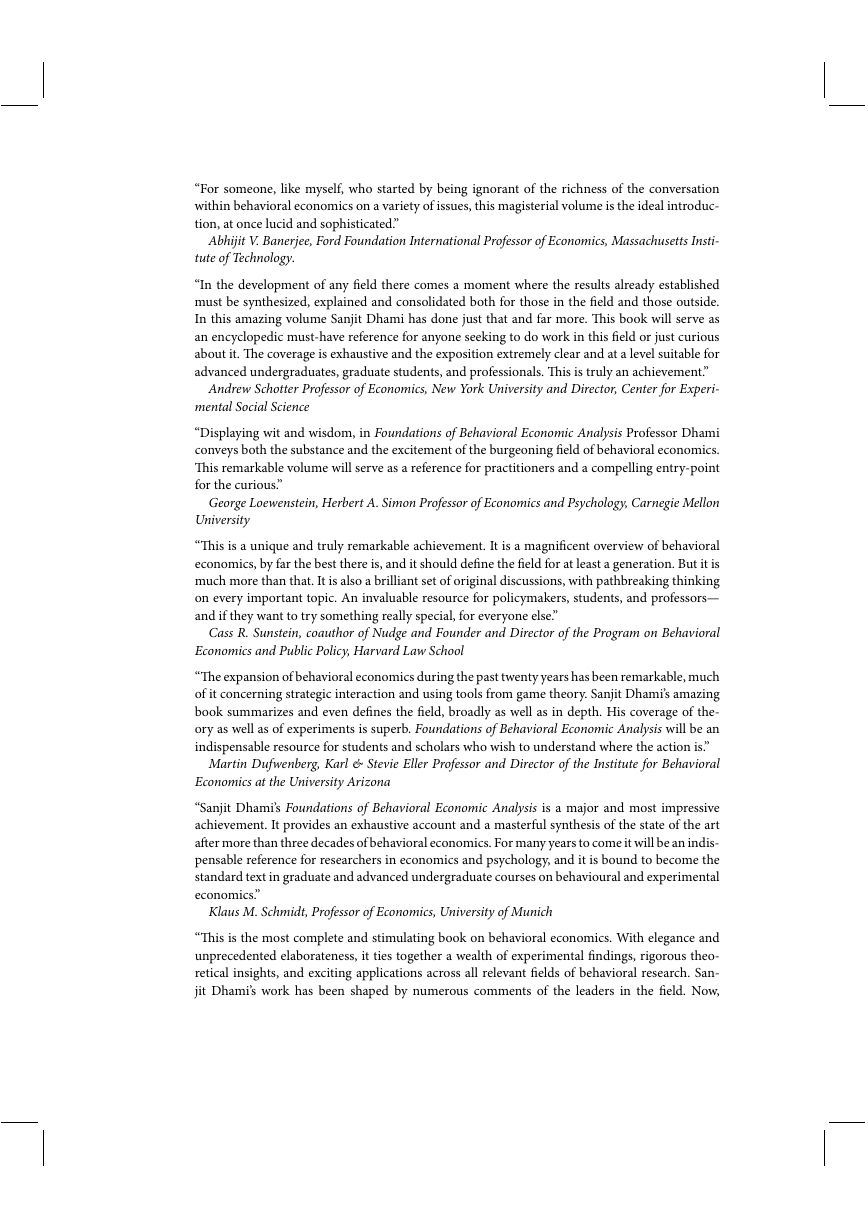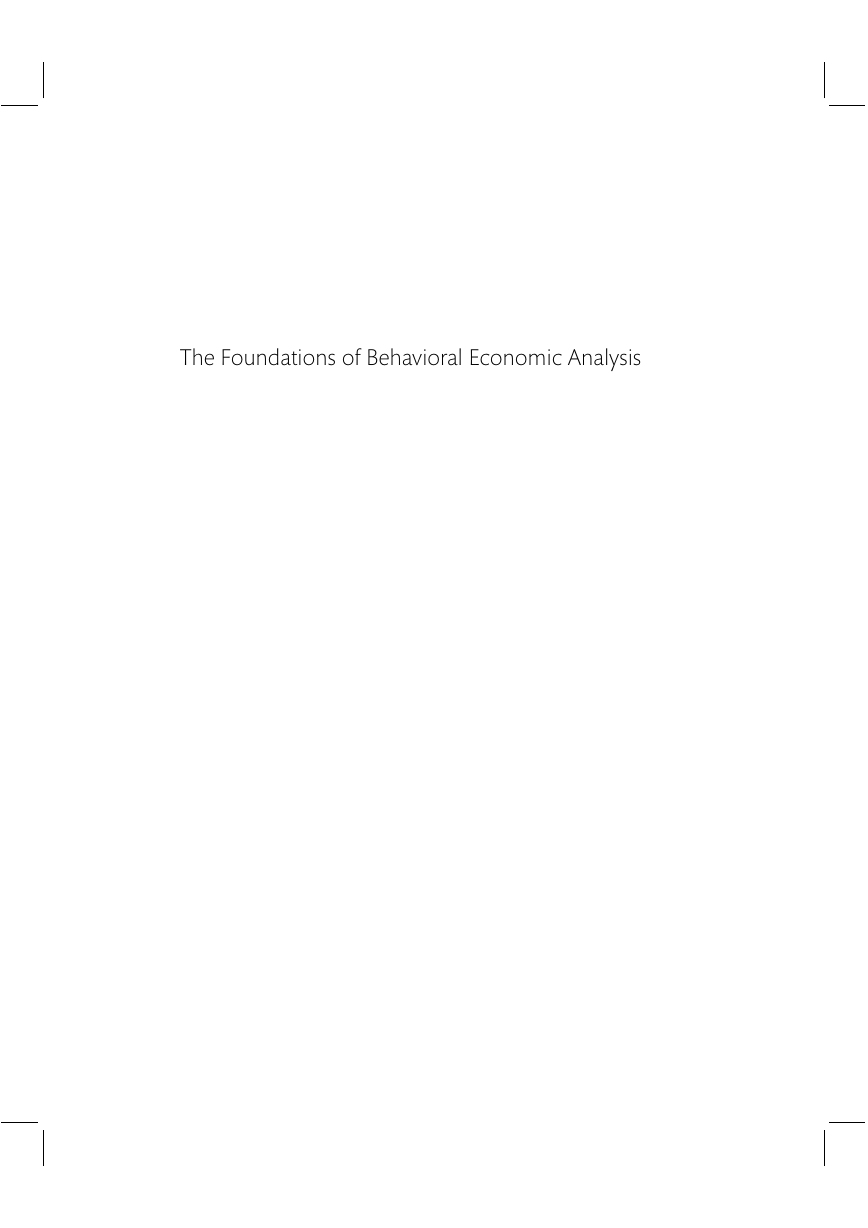Cover
The Foundations of Behavioral Economic Analysis
Copyright
Dedication
PREFACE AND ACKNOWLEDGMENTS
CONTENTS
LIST OF FIGURES
LIST OF TABLES
Introduction
1 The antecedents of behavioral economics
2 On methodology in economics
3 The experimental method in economics
3.1 Experiments and internal validity
3.2 Subject pools used in lab experiments
3.3 Stake sizes in experiments
3.4 The issue of the external validity of lab findings
3.5 The role of incentives in economics
3.6 Is survey data of any use?
4 Approach and organization of the book
5 Five theoretical approaches in behavioral economics
5.1 A case study of prospect theory
5.2 Human sociality and inequity averse preferences
5.3 The quasi-hyperbolic model and self-control problems
5.4 Level-k and CH models: disequilibrium in beliefs in strategic interaction
5.5 The heuristics and biases program: radical behavioral economics
6 Five examples of behavioral evidence
6.1 Does competitive market equilibrium survive fairness considerations?
6.2 Why do we not let bygones be bygones?
6.3 Are financial markets efficient?
6.4 Is expert behavior consistent with neoclassical economics?
6.5 Do people play a mixed strategy Nash equilibrium?
Appendix A: The random lottery incentive mechanism
Appendix B: In lieu of a problem set
References
PART 1: Behavioral Economics of Risk, Uncertainty, and Ambiguity
Introduction to part 1
CHAPTER 1: The Evidence on Human Choice under Risk and Uncertainty
1.1 Introduction
1.2 The elements of classical decision theory
1.2.1 Preference foundations of expected utility theory (EU)
1.2.2 Attitudes to risk under EU
1.3 Subjective expected utility theory (SE
1.4 Eliciting the utility function under EU
1.4.1 The case of known probabilities
1.4.2 The case of unknown probabilities
1.5 Violations of expected utility theory
1.5.1 Violations of the independence axiom
1.5.2 The probability triangle and violations of the axioms of rationality
1.5.3 Some attempts to relax the independence axiom
1.5.4 Attitudes to risk for small and large stakes: Rabin’s paradox
1.5.5 Violations of description invariance
1.5.6 Preference reversals
1.5.7 Is the reduction axiom supported by the evidence?
CHAPTER 2: Behavioral Models of Decision Making
2.1 Introduction
2.2 Probability weighting functions
2.2.1 Prelec’s probability weighting function
2.2.2 Stochastic dominance under non-linear probability weighting
2.3 Rank dependent utility theory (RDU)
2.3.1 Attitudes to risk under RDU
2.3.2 RDU under uncertainty
2.3.3 Drawbacks of RDU
2.4 Prospect theory (PT)
2.4.1 A brief note on PT under uncertainty
2.4.2 Attitudes to risk under prospect theory
2.4.3 A violation of EU and RDU that can be explained by PT
2.4.4 Some erroneous criticisms of PT
2.5 Elicitation of utility and probability weighting functions in PT
2.5.1 Elicitation of the utility function under PT
2.5.2 Elicitation of loss aversion under PT
2.5.3 Elicitation of the probability weighting function under PT
2.6 The axiomatic foundations of PT
2.6.1 Foundations of PT in terms of the trade-off consistency method
2.6.2 Foundations of the Prelec weighting function
2.7 Third generation PT and stochastic reference points
2.8 Stochastic reference points in PT under rational expectations
2.8.1 An example of a choice acclimating equilibrium (CPE): The newsvendor problem
2.8.2 An example of an unacclimating personal equilibrium (UPE): The taxi drivers’ problem
2.8.3 Some empirical evidence for Köszegi–Rabin preferences
2.9 Limitations of PT
2.9.1 The evidence and critique from configural weights models
2.9.2 Violations of gain–loss separability
2.9.3 Interaction between probability weights and stake sizes
2.9.4 Heterogeneity in preferences
2.10 A selection of other behavioral theories
2.10.1 Regret theory
2.10.2 The theory of disappointment aversion
2.10.3 Salience and context in decision theory
2.10.4 Case-based decision theory
2.10.5 Configural weights models
THE RANK AFFECTED MULTIPLICATIVE WEIGHTS MODEL (RAM)
TRANSFER OF ATTENTION IN EXCHANGE MODELS (TAX)
THE GAINS DECOMPOSITION UTILITY MODEL (GDU)
AN EVALUATION OF THE CONFIGURAL WEIGHTS MODELS
2.11 Human behavior for extreme probability events
2.11.1 Original prospect theory (OPT)
2.11.2 The evidence on behavior under low probability events
INSURANCE FOR LOW PROBABILITY EVENTS
THE BECKER (1968) PARADOX
EVIDENCE FROM JUMPING RED TRAFFIC LIGHTS
OTHER EXAMPLES OF HYPOTHESIS H2
CONCLUSION FROM THESE DISPARATE CONTEXTS
2.11.3 Composite Prospect Theory
A BRIEF, MORE FORMAL TREATMENT OF THE CPF
DEFINITIONS OF CPT AND CRDU
2.12 Risk preferences and time preferences
2.12.1 Can non-linear probability weighting explain temporal behavior under risk?
2.12.2 Intertemporal risk aversion
2.12.3 An agenda for the future
2.12.4 Delay dependence and probability weighting
2.12.5 Probability weighting and process dependence
CHAPTER 3: Applications of Behavioral Decision Theory
3.1 Introduction
3.2 The endowment effect and exchange asymmetries
3.2.1 Loss aversion and the endowment effect
3.2.2 Is there any risk aversion beyond loss aversion?
3.2.3 Market experience and loss aversion
3.2.4 Subject misinterpretation as explanation of exchange asymmetries
3.2.5 Other implications/explanations of the endowment effect
PROPERTY RIGHTS AND EXCHANGE ASYMMETRIES
SOME MARKETING IMPLICATIONS OF EXCHANGE ASYMMETRIES
STOCHASTIC REFERENCE POINTS
A QUERY THEORY OF VALUE CONSTRUCTION
UNCERTAINTY AND EXCHANGE ASYMMETRIES
3.3 Prospect theory preferences in primates
3.4 Myopic loss aversion
3.5 Why do people pay taxes?
THE BASIC SET UP
THE TAX EVASION DECISION UNDER EXPECTED UTILITY
THE TAX EVASION DECISION UNDER PROSPECT THEORY
MODEL CALIBRATION
3.6 Explanation of Rabin’s paradox using PT
3.7 Goals as reference points
3.7.1 A theory of goals in prospect theory
3.7.2 The evidence on goals
3.8 Why is it so hard to find a taxi on a rainy day in New York?
3.9 Some implications of inverse S-shaped weighting functions
3.10 Contracts as reference points
3.10.1 A simple model
3.10.2 Empirical evidence for contracts as reference points
3.11 Moral hazard, loss aversion, and optimal contracts
3.12 Renegotiation, long-term contracts, and loss aversion
CHAPTER 4: Human Behavior under Ambiguity
4.1 Introduction
4.2 A problem for SEU: The Ellsberg paradox
4.3 Neoclassical models of ambiguity
4.3.1 Choquet expected utility
4.3.2 Models of multiple priors
4.3.3 Two-stage recursive models and failure of compounding
4.3.4 The smooth ambiguity aversion model
4.3.5 A brief note on the related literature
4.3.6 Some empirical evidence on ambiguity aversion
4.4 Behavioral models of ambiguity
4.4.1 Support theory
4.4.2 Prospect theory, source-dependent uncertainty, and ambiguity
Exercises for Part 1
References for part 1
PART 2: Other-Regarding Preferences
Introduction to part 2
CHAPTER 5: The Evidence on Human Sociality
5.1 Introduction
5.2 Ultimatum and dictator games
5.2.1 The ultimatum game
5.2.2 The dictator game
5.2.3 Rationality of other-regarding preferences in dictator games
5.3 Gift exchange and trust games
5.3.1 The gift exchange game
GIFT EXCHANGE AND COMPETITIVE EQUILIBRIUM
GIFT EXCHANGE AND SOCIAL COMPARISONS
GIFT EXCHANGE AND DURATION EFFECTS
REFERENCE DEPENDENCE AND GIFT EXCHANGE
SURVEY EVIDENCE FOR GIFT EXCHANGE
5.3.2 The trust game, trust, and trustworthiness
RELATION BETWEEN THE GIFT EXCHANGE GAME AND THE TRUST GAME
5.4 Public goods games
5.4.1 Public goods game without punishments
5.4.2 Public goods game with punishments
5.4.3 Empirical evidence on public goods games
5.4.4 Heterogenous preferences and the pattern of contributions
5.4.5 Unproductive expenditures on public goods
5.4.6 Antisocial punishments
5.4.7 Evolution and reciprocity
5.5 How representative is the lab evidence?
5.5.1 The student subject pool and experimental scrutiny
5.5.2 The external validity of experiments on other-regarding preferences
5.6 Indirect reciprocity
CHAPTER 6: Models of Other-Regarding Preferences
6.1 Introduction
6.2 The Fehr–Schmidt model
6.2.1 Fairness and market competition
MARKET GAMES WITH PROPOSER COMPETITION
MARKET GAMES WITH RESPONDER COMPETITION
6.2.2 Fairness and cooperation
PUBLIC GOODS GAME WITHOUT PUNISHMENTS
PUBLIC GOODS GAME WITH PUNISHMENTS
6.3 The ERC model
6.4 Fairness and stochastic dominance
6.5 Behavioral political economy
6.5.1 Existence of a Condorcet winner when voters have social preferences
6.5.2 Heterogeneity in voter preferences and redistribution
6.6 Fairness, general equilibrium, and welfare
6.7 Evidence on models of social preference and reciprocity
6.7.1 The evidence on models of social preferences
6.7.2 The evidence on intentions and reciprocity
INTENTIONS, INEQUITY AVERSION, AND FAIRNESS REFERENCE POINTS
6.8 A discussion of other promising models
6.8.1 The Charness and Rabin (2002) hybrid model
6.8.2 Models of interdependent preferences
6.8.3 The model of Cox, Friedman, and Gjerstad (2007)
6.8.4 A brief note on axiomatic foundations
CHAPTER 7: Human Morality and Social Identity
7.1 Introduction
7.2 Human virtues
7.2.1 Evidence on human virtues
7.2.2 A theoretical model of promises and threats
7.3 Social identity
7.3.1 Evidence on social identity and other-regarding preferences
7.3.2 Identity and economic incentives
PRINCIPAL APPOINTS A SUPERVISOR (REGIME-I)
THE PRINCIPAL DOES NOT APPOINT A SUPERVISOR (REGIME-II)
CHAPTER 8: Incentives and Other-Regarding Preferences
8.1 Introduction
8.2 Moral hazard and other-regarding preferences
8.2.1 Inequity aversion and moral hazard
8.2.2 Reciprocity and moral hazard
8.3 Incomplete contracts under other-regarding preferences
8.3.1 Optimal contracts under self-regarding preferences
8.3.2 Optimal contracts in the presence of other-regarding preferences
TRUST CONTRACTS
8.3.3 Evidence on contract choice under contractual incompleteness
8.4 Reciprocity and long-term contracts
8.4.1 The outcome with self-regarding preferences
8.4.2 The outcome with other-regarding preferences
8.4.3 Experimental results
THE SOLUTION UNDER ASYMMETRIC INFORMATION
8.4.4 The nature of the firm and other-regarding preferences
8.5 Extrinsic and intrinsic motivation: theoretical framework
8.5.1 Self-signaling and social signaling
8.5.2 Intentions, altruism, and esteem
8.6 Extrinsic and intrinsic motivation: empirical evidence
8.6.1 Incentives may signal a hostile intent
8.6.2 Control aversion and choking under high incentives
8.6.3 Moral disengagement
8.6.4 Morality may be difficult to signal in the presence of incentives
8.6.5 Economic environment, learning, and incentives
8.6.6 Crowding-in effect of incentives
Exercises for Part 2
References for part 2
PART 3: Behavioral Time Discounting
Introduction to part 3
CHAPTER 9: The Evidence on Temporal Human Choice
9.1 Introduction
9.2 The discounted utility model
9.3 The exponential discounted utility model (EDU)
9.3.1 Some salient properties of the EDU model
9.3.2 Time consistency of consumption plans under EDU
9.3.3 A note on eliciting time preferences under EDU
9.3.4 Axiomatic foundations of EDU
9.4 Anomalies of the EDU model
9.4.1 Hyperbolic discounting and the common difference effect
9.4.2 The gain–loss asymmetry
9.4.3 The absolute magnitude effect
9.4.4 The delay–speedup asymmetry
9.4.5 Front-end delay dependence
9.4.6 Subadditive discounting
9.4.7 Cyclical or non-transitive choices
9.4.8 Preferences for increasing sequences
9.4.9 Violations of consumption independence
9.4.10 Effects of individual-specific traits on the discount rate
CHAPTER 10: Behavioral Models of Time Discounting
10.1 Introduction
10.2 Explaining the sign and magnitude effects
10.2.1 The Loewenstein–Prelec explanation
10.2.2 The class of simple increasing elasticity utility functions
10.3 Explaining the common difference effect
10.3.1 Hyperbolic discounting
THE GENERAL MODEL OF HYPERBOLIC DISCOUNTING
EMPIRICAL EVIDENCE ON HYPERBOLIC DISCOUNTING
10.3.2 Subadditive discounting
10.3.3 Uncertainty
10.4 Attribute-based models
10.4.1 Vague time preferences model
10.4.2 The similarity relation and time preference
10.4.3 Trade-off attribute model of intertemporal choice
10.5 The reference time theory (RT)
10.5.1 A basic description of RT
10.5.2 The implications of additivity of discount functions for RT
10.5.3 Explanation of intransitive preferences under RT
10.5.4 Recasting common discount functions in terms of RT
10.5.5 Explanation of the EDU anomalies in RT
DELAY FUNCTION, �
SPEEDUP FUNCTION, f
THE GENERATING FUNCTION
CHARACTERIZING OBSERVED BEHAVIOR FROM THE UNDERLYING FUNCTIONS
10.5.6 Intransitive preferences and relative discounting
CHAPTER 11: Applications of Present-Biased Preferences
11.1 Introduction
11.2 Two frameworks for modeling present-biased preferences
11.2.1 Planner–doer models
11.2.2 Multiple selves and the degree of awareness
11.3 Optimal consumption under hyperbolic discounting
11.3.1 Benchmark case: time consistent preferences
11.3.2 The solution under limited awareness
11.3.3 Mitigating self-control problems in the life-cycle model
SOLUTION IN THE PRESENCE OF COMMITMENT
ILLIQUID ASSETS AND ABSENCE OF COMMITMENT
11.3.4 Euler equations in a general life-cycle problem
THE EULER EQUATION UNDER EXPONENTIAL DISCOUNTING
THE EULER EQUATION UNDER HYPERBOLIC DISCOUNTING AND SOPHISTICATED MULTIPLE SELVES
11.3.5 Missing precautionary savings effects
11.3.6 Relation between intertemporal substitution and risk
11.3.7 Patience heterogeneity: covariation with wealth and age
11.4 Endogenous retirement decisions
11.5 Procrastination and preproperation
11.5.1 The case of immediate costs
11.5.2 The case of immediate rewards
11.5.3 A brief note on welfare comparisons
11.5.4 Some other features of present bias
11.6 Interdependence, multiple activities, and competition
11.7 Optimal sin taxes
11.7.1 First best allocation
11.7.2 Privately optimal choice
11.7.3 Implementation of the first best
11.7.4 Population heterogeneity
11.8 Investment and leisure goods
11.8.1 Investment goods
THE CONSUMER’S PROBLEM
THE FIRM’S PROBLEM
11.8.2 Leisure goods
11.8.3 Empirical results
11.9 Other applications of hyperbolic discounting
Exercises for Part 3
References for part 3
PART 4: Behavioral Game Theory
Introduction to part 4
CHAPTER 12: The Evidence on Strategic Human Choice
12.1 Introduction
12.2 Iterated deletion of dominated strategies
12.2.1 Failure of two steps of iterated dominance
12.2.2 Framing effects and failure of three steps of iterated dominance
12.2.3 Centipede games and failure of higher order steps of iterated dominance
12.2.4 Evidence from mechanism design problems that are dominance solvable
THE GLAZER–PERRY MECHANISM
12.3 Mixed strategy Nash equilibria
12.3.1 Do people play mixed strategy equilibria in games within a general context?
12.3.2 Do people play MSE in games within an economic context?
12.3.3 Do people play MSE when they have a mixed strategy device?
12.3.4 Do professionals play mixed strategy equilibria?
MINIMAX PLAY BY PROFESSIONAL SPORTS PLAYERS
IS MSE PLAY TRANSFERABLE ACROSS CONTEXTS FOR PROFESSIONAL SPORTS PLAYERS?
12.4 Coordination games
12.4.1 Evidence on coordination failures
12.4.2 Focal points and coordination
12.4.3 Coordination failures in median action games
12.4.4 Coordination failures in weak link games
12.4.5 More evidence on equilibrium selection principles
12.4.6 Coordination and the optimization premium in stag-hunt games
12.4.7 Forward induction, timing, and coordination failures
12.4.8 Preplay communication and coordination failures
12.4.9 Historical accidents and choice among coordination equilibria
12.4.10 Financial incentives and coordination
12.4.11 Loss aversion and coordination
12.4.12 Achieving coordination with gradual growth in group sizes
12.4.13 Intergenerational advice and coordination
12.4.14 External arbiter recommendations
12.4.15 Communication, experience, and coordination
12.4.16 Coordination in repeated games
12.5 Bargaining games
12.5.1 Normative bargaining solutions
12.5.2 Positive bargaining solutions
BARGAINING UNDER FULL INFORMATION
BARGAINING UNDER ASYMMETRIC INFORMATION
Two-sided asymmetric information
12.5.3 Self-serving bias and focal points in bargaining
12.5.4 Inferring cognition through search and lookups in a bargaining game
12.6 Asymmetric information, signaling, and cheap talk
12.6.1 Evidence from a generic signaling game
12.6.2 An application to a limit entry pricing game
12.6.3 Finitely repeated games of asymmetric information
12.6.4 Signaling in corporate finance
12.6.5 Leader contributions to charitable giving: signaling or reciprocity?
12.6.6 Multiple signals
12.6.7 Two-sided asymmetric information
12.7 Public signals and correlated equilibria
12.8 Strategic complements and strategic substitutes
12.8.1 Implications of SS and SC for the degree of cooperation
12.8.2 The macroeconomics of nominal inertia
12.9 A digression on competitive equilibrium experiments
12.9.1 The original market experiments by Chamberlin (1948)
12.9.2 Double auction tests of a competitive equilibrium
12.9.3 Agent-based models of competitive double auction markets
12.9.4 Evaluating the experimental evidence on competitive markets
CHAPTER 13: Models of Behavioral Game Theory
13.1 Introduction
13.2 Quantal response equilibrium (QRE)
13.2.1 QRE in normal form games
13.2.2 QRE in extensive form games
13.2.3 Does the QRE impose falsifiable restrictions?
13.2.4 An application of QRE to the traveller’s dilemma game
13.3 Level-k and cognitive hierarchy models
13.3.1 The level-k model
13.3.2 The p-beauty contest
13.3.3 The cognitive hierarchy model (CH)
13.4 Applications of level-k and CH models
13.4.1 Is the power of focal points limited?
13.4.2 Coordination and communication with boundedly rational players
THE OUTCOME UNDER CLASSICAL GAME THEORY
THE OUTCOME UNDER A LEVEL-K MODEL WITH NO COMMUNICATION
THE OUTCOME UNDER A LEVEL-k MODEL WITH TWO-WAY COMMUNICATION
13.4.3 Risk dominance and payoff dominance in sender–receiver games
THE BENCHMARK CASE OF NO-COMMUNICATION
THE POSSIBILITY OF ONE-WAY COMMUNICATION
A SUMMARY
13.4.4 The market entry game
13.4.5 Empirical evidence on level-k models
13.4.6 Do non-strategic players exist?
13.5 Psychological game theory
13.5.1 Psychological Nash equilibria in single-stage games
13.5.2 Psychological sequential Nash equilibria in multi-stage games
A NOTE ON THE COMPARISON WITH GAMES OF ASYMMETRIC INFORMATION
13.5.3 Fairness and reciprocity in extensive form games
13.5.4 Fairness, reciprocity, and inequity-aversion in extensive form games
13.5.5 Guilt in games
13.5.6 Dependence of utility on plans
13.6 Correlated equilibrium and social norms
13.7 Other behavioral models of how people play games
13.7.1 Analogy-based equilibrium
13.7.2 Subjective heterogeneous quantal response equilibrium
13.7.3 Cursed equilibrium
13.7.4 Evidential equilibrium
IS EVIDENTIAL REASONING RATIONAL OR IS IT A USEFUL HEURISTIC?
WHY IS THERE SO MUCH COOPERATION IN THE PRISONER’S DILEMMA GAME?
EVIDENTIAL GAMES AND EVIDENTIAL EQUILIBRIUM
AN APPLICATION: THE PRISONER’S DILEMMA GAME
13.7.5 Noisy introspection
13.7.6 A brief note on some other models
13.8 Behavioral economics of auctions
13.8.1 Some basic results in auction theory
AUCTIONS WITH INDEPENDENT PRIVATE VALUES (IPV)
AUCTIONS WITH COMMON VALUES (CV)
13.8.2 Some empirical evidence on the predictions of the rational auctions model
13.8.3 Cursed equilibrium as an explanation of the winner’s curse
13.8.4 A level-k explanation of the winner’s curse
THE INCREASING DENSITY CASE WITH LEVEL-k PLAYERS
THE DECREASING DENSITY CASE WITH LEVEL-k PLAYERS
Exercise for Part 4
References for part 4
PART 5: Behavioral Models of Learning
Introduction to part 5
CHAPTER 14: Evolutionary Game Theory
14.1 Introduction
14.2 Some preliminaries
14.3 Evolutionary stable strategies in two-player games
14.4 Relation of ESS with other equilibrium concepts
14.5 Replicator dynamics
REPLICATOR DYNAMICS FOR THE ASYMMETRIC POPULATION CASE
14.6 Applications of evolutionary game theory
14.6.1 Prisoner’s dilemma game: monomorphic equilibrium
STATIC PRISONER’S DILEMMA GAME
DYNAMIC PRISONER’S DILEMMA GAME
14.6.2 The game of chicken: polymorphic equilibria
14.6.3 Non-existence of an asymptotically stable equilibrium
14.6.4 A two-population model of coordination
14.7 Playing the field
14.8 Gene-culture coevolution
14.8.1 Basics of gene–culture coevolution
14.8.2 A formal model of cultural evolution
14.9 The evolution of altruism and reciprocit
14.9.1 Kin selection and inclusive fitness
14.9.2 Group selection or multilevel selection
14.9.3 Reciprocal altruism or direct reciprocity
14.9.4 Indirect reciprocity
14.9.5 Repeated games, cooperation, and classical game theory
14.9.6 The indirect evolutionary approach
THE BASIC CONCEPTS
THE EVOLUTION OF MORALITY
14.9.7 Other issues in evolutionary explanations of cooperation
14.10 Social learning and replicator-like dynamics
14.10.1 Social imitation and emulation dynamics
14.10.2 Some microfoundations of replicator dynamics: imitation learning
14.10.3 Social dynamics based on payoff monotonicity
CHAPTER 15 Models of Learning
15.1 Introduction
15.2 Reinforcement learning
15.2.1 The one-parameter reinforcement learning model
15.2.2 The three-parameter model of reinforcement learning
15.2.3 Some other variants of reinforcement learning
15.2.4 Optimality of reinforcement learning in a stationary environment
15.2.5 Empirical evidence on reinforcement learning
15.3 Belief-based models of learning
15.3.1 Empirical evidence on some belief-based models
15.3.2 Reinforcement learning versus fictitious play: empirical evidence
15.4 The experience weighted attraction model of learning
15.4.1 Special case: reinforcement learning
15.4.2 Special case: belief-based learning
15.4.3 Empirical evidence for the EWA
15.4.4 Functional EWA (fEWA)
15.4.5 Sophisticated EWA learning and strategic teaching
15.5 Learning models: two points of view
15.6 The class of learning direction theories
15.6.1 Learning direction theory
15.6.2 Impulse matching theories
IMPULSE MATCHING LEARNING
IMPULSE BALANCE EQUILIBRIUM
ACTION-SAMPLE LEARNING
PAYOFF-SAMPLING LEARNING
EMPIRICAL EVIDENCE ON LEARNING DIRECTION MODELS
15.6.3 An explanation of the data from order statistic games
15.7 Rule-based learning
15.7.1 A formal model of rule learning
15.7.2 Evidence from rule-based models
15.8 Multiple games, complexity, and categorization
15.9 Possibility and impossibility of rational learning
CHAPTER 16: Stochastic Social Dynamics
16.1 Introduction
16.2 Fixing ideas in stochastic dynamics
16.2.1 Stochastic dynamics in a coordination game
16.2.2 A model of technology adoption
16.3 Perturbed Markov dynamics in 2 × 2 games
16.3.1 Dominated strategies as stochastically stable states
16.3.2 Risk dominance under perturbed dynamics
16.3.3 Extensions of the basic model
16.4 Memory, conventions, and risk dominance in 3 × 3 games
16.4.1 Boundedly rational play and fully rational outcomes
16.4.2 Of norms and social evolution
16.4.3 A brief selection of further applications
16.5 Social networks
16.5.1 An application to agrarian contracts
Appendices
Appendix A: Ordinary differential equations
SOLUTION OF AN ODE
STEADY STATES AND STABILITY
Appendix B: A note on choice under stochastic utility
Appendix C: A brief user’s guide to Markov Chains
PERTURBED MARKOV CHAINS
THE METHOD OF YOUNG (1993A)
THE METHOD OF ELLISON (2000)
Exercises for Part 5
References for part 5
PART 6: Emotions
Introduction to part 6
CHAPTER 17: Emotions and Human Behavior
17.1 Introduction
17.2 Visceral influences and the rationality of emotions
17.2.1 Visceral influences
17.2.2 Rationality and emotions
17.3 Cue-conditioned behavior and habit formation
17.3.1 Solution to the no-cues model
17.3.2 Solution to the cues model
17.4 Anticipation and delay under certainty
17.5 Fear and anxiety under uncertainty
17.5.1 An outline of the framework
17.5.2 Life-cycle consumption, portfolio choice, and asset prices under anxiety
17.6 Projection bias
17.6.1 Preferences under projection bias
17.6.2 Habit formation, life-cycle consumption, and projection bias
17.6.3 An application to consumer durables
17.6.4 Other applications of projection bias
17.7 Temptation preferences: a revealed preference approach
17.7.1 The formal model
17.7.2 Interpreting temptation preferences in a planner–doer framework
17.8 Temptation and conflicts between commitment and flexibility
17.8.1 First best outcome
17.8.2 The optimal commitment solution under asymmetric information
17.8.3 Some empirical evidence on self-control
17.9 Happiness economics
17.9.1 Why should we be interested in subjective well-being?
17.9.2 The relation between life-satisfaction/happiness and GDP
17.9.3 Other important economic correlates of well-being
UNEMPLOYMENT AND INFLATION
INCOME INEQUALITY AND HAPPINESS
HEALTH SATISFACTION AND HAPPINESS
SOCIAL CAPITAL AND HAPPINESS
DEMOCRACY, FREEDOM, AND LIFE SATISFACTION
CHAPTER 18: Interactions between Emotions and Cognition
18.1 Introduction
18.2 Emotions and a two-modules view of the brain
18.2.1 An introduction to the two-modules view
18.2.2 An illustrative framework
INTERTEMPORAL CHOICE
BEHAVIOR UNDER RISK
SOCIAL PREFERENCES
A NOTE ON WELFARE COMPARISON
18.3 A dual selves model with costly commitment
18.3.1 The model without commitment
18.3.2 Commitment via a cash-in-advance constraint
18.4 Information asymmetries between emotions and cognition
18.4.1 The full information equilibrium
18.4.2 The asymmetric information equilibrium
18.5 Strategic ignorance, confidence, and self-esteem
18.5.1 Strategic ignorance
18.5.2 Confidence, motivation, and self-esteem
MAINTAINING THE OPTIMAL DEGREE OF CONFIDENCE
DEGREES OF SELF-CONFIDENCE
SELF-HANDICAPPING AND SELF-ESTEEM
AWARENESS MANAGEMENT
PERSONAL EVALUATION BIASES AND BAYES’ RULE
WILLPOWER AND PERSONAL RULES
Exercises for Part 6
References for part 6
PART 7: Bounded Rationality
Introduction to part 7
CHAPTER 19: Judgment Heuristics
19.1 Introduction
19.2 The law of small numbers
19.2.1 Representativeness heuristic
19.2.2 Gambler’s fallacy and hot-hands fallacy
INABILITY TO PRODUCE A SEQUENCE OF RANDOM NUMBERS
GAMBLER’S FALLACY
HOT HANDS FALLACY
WHY DO THESE FALLACIES ARISE?
19.2.3 A formal model of the law of small numbers
CERTAINTY ABOUT THE TRUE θ AND THE GAMBLER’S FALLACY
UNCERTAINTY ABOUT THE TRUE θ AND OVERCONFIDENCE
19.3 Conjunction fallacy
19.3.1 Does a natural frequency format resolve the conjunction fallacy?
19.3.2 Do monetary incentives and groupthink eliminate the conjunction fallacy?
19.3.3 Why does the conjunction fallacy arise?
19.4 The availability heuristic
19.5 The affect heuristic
19.5.1 Empirical evidence for the affect heuristic
19.5.2 The relative affectiveness of the probability and frequency formats
19.6 Anchoring and adjustment
19.6.1 Empirical evidence for anchoring
19.6.2 Legal and regulatory implications of anchoring
19.6.3 Robustness of anchoring
19.6.4 Explanations of anchoring
19.7 Base rate neglect and conservatism
19.7.1 Base rate neglect
19.7.2 Conservatism
19.7.3 A reconciliation of conservatism and base rate neglect
19.8 Hindsight bias
19.8.1 Empirical evidence on the hindsight bias
19.8.2 Hindsight bias in legal situations
19.8.3 What causes hindsight bias?
19.8.4 Hindsight bias and the underestimation of financial volatility
19.9 Confirmation bias
19.9.1 Empirical evidence for confirmation bias
19.9.2 A formal model of confirmation bias and overconfidence
19.10 Other judgment heuristics
19.10.1 Regression towards the mean
19.10.2 False consensus effect
19.10.3 Confusion between necessary and sufficient conditions
19.10.4 Attribute substitution
19.11 Dual process models and judgment heuristics
19.12 Coarse thinking and persuasion
19.13 Mental models
19.14 Herbert Simon’s approach to bounded rationality
19.14.1 Aspiration adaptation theory
19.14.2 Fast and frugal heuristics
TWO EXAMPLES OF FAST AND FRUGAL HEURISTICS
THE RECOGNITION HEURISTIC AND THE TAKE-THE-BEST HEURISTIC
19.15 The great rationality debate
19.16 Shrouded attributes
19.16.1 Empirical evidence
19.16.2 A theoretical framework
19.17 Limited attention
19.17.1 Limited attention and the poor
19.17.2 Limited attention and taxes
19.17.3 Biased numerical attention
19.17.4 A theoretical framework
19.18 Do experts exhibit biases?
CHAPTER 20 Mental Accounting
20.1 Introduction
20.1.1 Some examples of mental accounting
20.1.2 An introduction to the chapter
20.2 Framing and mental accounting
20.3 Prospect theory and mental accounting
20.4 The behavioral life-cycle model
20.4.1 Mental accounting and the life-cycle model
20.4.2 Some predictions of the mental accounts model
20.5 The red and black of mental accounting
20.6 Choice bracketing
20.7 Coherent arbitrariness
20.8 Sunk costs and mental accounting
20.9 Some other mental accounting phenomena
20.9.1 Transaction utility and acquisition utility
20.9.2 When to close an account?
20.9.3 Self-control and gift giving
AN EXAMPLE: THE FOOD STAMP PROGRAM
20.9.4 The house money effect
20.9.5 The diversification heuristic
20.9.6 The mental accounting of goals
20.9.7 The behavioral economics of retirement savings
CHAPTER 21: Bounded Rationality in Financial Markets
21.1 Introduction
21.2 The efficient markets hypothesis
21.2.1 An introduction to short selling
21.2.2 Statement and implications of EMH
21.2.3 Evaluating the theoretical case for EMH
21.2.4 The empirical evidence on efficiency of financial markets
21.3 Noise trader risk
21.4 The limits to arbitrage
21.5 Gradual flow of information
21.6 Stock market underreaction and overreaction
21.7 Behavioral corporate finance
21.7.1 An introduction to managerial biases
21.7.2 Rational managers, irrational investors, and merger/acquisition activity
21.7.3 Managerial overconfidence with rational investors
THE RATIONAL MANAGER BENCHMARK
THE OVERCONFIDENT MANAGER’S INVESTMENT DECISION
21.7.4 Behavioral corporate signaling
21.8 Exercises for Part 7
References for part 7
PART 8: Behavioral Welfare Economics
Introduction to part 8
CHAPTER 22: Behavioral Welfare Economics
22.1 Introduction
22.2 Fixing basic ideas
22.2.1 The basic framework
22.2.2 Direct paternalism
22.2.3 Indirect paternalism
22.2.4 Libertarian paternalism
22.2.5 Effect of other policies
22.3 Soft paternalism
22.3.1 Libertarian paternalism
22.3.2 Asymmetric paternalism
22.3.3 A pragmatic approach
22.3.4 Some applications of soft paternalism
THE ROLE OF DEFAULTS
RETIREMENT SAVINGS AND DEFAULTS
OBESITY
COOLING-OFF PERIODS
DEADLINES
22.3.5 A critique of soft paternalism
22.3.6 A note on behavioral welfare criteria
22.4 Regulation under imperfect self-information
22.5 Choice and non-choice data: What is the scope of economics?
22.6 Choice-based behavioral welfare economics
22.7 Revealed preference under limited attention
22.8 The contractarian approach
22.9 Behavioral public finance and welfare
22.9.1 Tax incidence under limited attention
22.9.2 Excess burden under limited attention
22.9.3 A note on reduced-form approaches to behavioral public finance
Exercises for Part 8
References for part 8
PART 9: Neuroeconomics
Introduction to part 9
CHAPTER 23: Neuroeconomics
23.1 Introduction
23.2 A brief introduction to the brain
23.3 An introduction to neuroeconomic techniques
23.3.1 Criteria for evaluating neuroeconomic measurement techniques
23.3.2 Single unit recording
23.3.3 Electroencephalography and magnetoencephalography
23.3.4 Positron Emission Tomography
23.3.5 Functional magnetic resonance imaging
23.3.6 Manipulation techniques
TRANSCRANIAL MAGNETIC STIMULATION
TRANSCRANIAL DIRECT CURRENT STIMULATION
BRAIN LESION STUDIES
23.4 The neuroeconomics of risky decisions
23.4.1 Neural basis of value and risk
23.4.2 Reference dependence
23.4.3 Loss aversion
23.4.4 Non-linear probability weighting
23.5 The neuroeconomics of social preferences
23.5.1 Computation of social rewards in the brain
23.5.2 The neural basis of inequity averse preference
23.5.3 Neural basis of social punishment and trust
23.5.4 Human virtues and the brain
23.5.5 Neural interplay of guilt and social preferences
23.6 The neuroeconomics of time preferences
23.7 The neuroeconomics of strategic interaction
23.8 Pharmacoeconomics: an application to social effects of oxytocin
References for part 9
APPENDIX ON GAME THEORY
A.1 Introduction
A.2 Normal form games
A.3 A basic taxonomy of some normal form games
A.4 Two-person zero-sum games
A.5 Selection criteria among Nash equilibria: payoff dominance and risk dominan
A.6 Extensive form games
A.7 Games of incomplete information
A.7.1 Finite Bayesian games of incomplete information
A.7.2 Signaling games
A.8 Correlated equilibrium
References
INDEX OF NAMED AUTHORS
SUBJECT INDEX
















 2023年江西萍乡中考道德与法治真题及答案.doc
2023年江西萍乡中考道德与法治真题及答案.doc 2012年重庆南川中考生物真题及答案.doc
2012年重庆南川中考生物真题及答案.doc 2013年江西师范大学地理学综合及文艺理论基础考研真题.doc
2013年江西师范大学地理学综合及文艺理论基础考研真题.doc 2020年四川甘孜小升初语文真题及答案I卷.doc
2020年四川甘孜小升初语文真题及答案I卷.doc 2020年注册岩土工程师专业基础考试真题及答案.doc
2020年注册岩土工程师专业基础考试真题及答案.doc 2023-2024学年福建省厦门市九年级上学期数学月考试题及答案.doc
2023-2024学年福建省厦门市九年级上学期数学月考试题及答案.doc 2021-2022学年辽宁省沈阳市大东区九年级上学期语文期末试题及答案.doc
2021-2022学年辽宁省沈阳市大东区九年级上学期语文期末试题及答案.doc 2022-2023学年北京东城区初三第一学期物理期末试卷及答案.doc
2022-2023学年北京东城区初三第一学期物理期末试卷及答案.doc 2018上半年江西教师资格初中地理学科知识与教学能力真题及答案.doc
2018上半年江西教师资格初中地理学科知识与教学能力真题及答案.doc 2012年河北国家公务员申论考试真题及答案-省级.doc
2012年河北国家公务员申论考试真题及答案-省级.doc 2020-2021学年江苏省扬州市江都区邵樊片九年级上学期数学第一次质量检测试题及答案.doc
2020-2021学年江苏省扬州市江都区邵樊片九年级上学期数学第一次质量检测试题及答案.doc 2022下半年黑龙江教师资格证中学综合素质真题及答案.doc
2022下半年黑龙江教师资格证中学综合素质真题及答案.doc